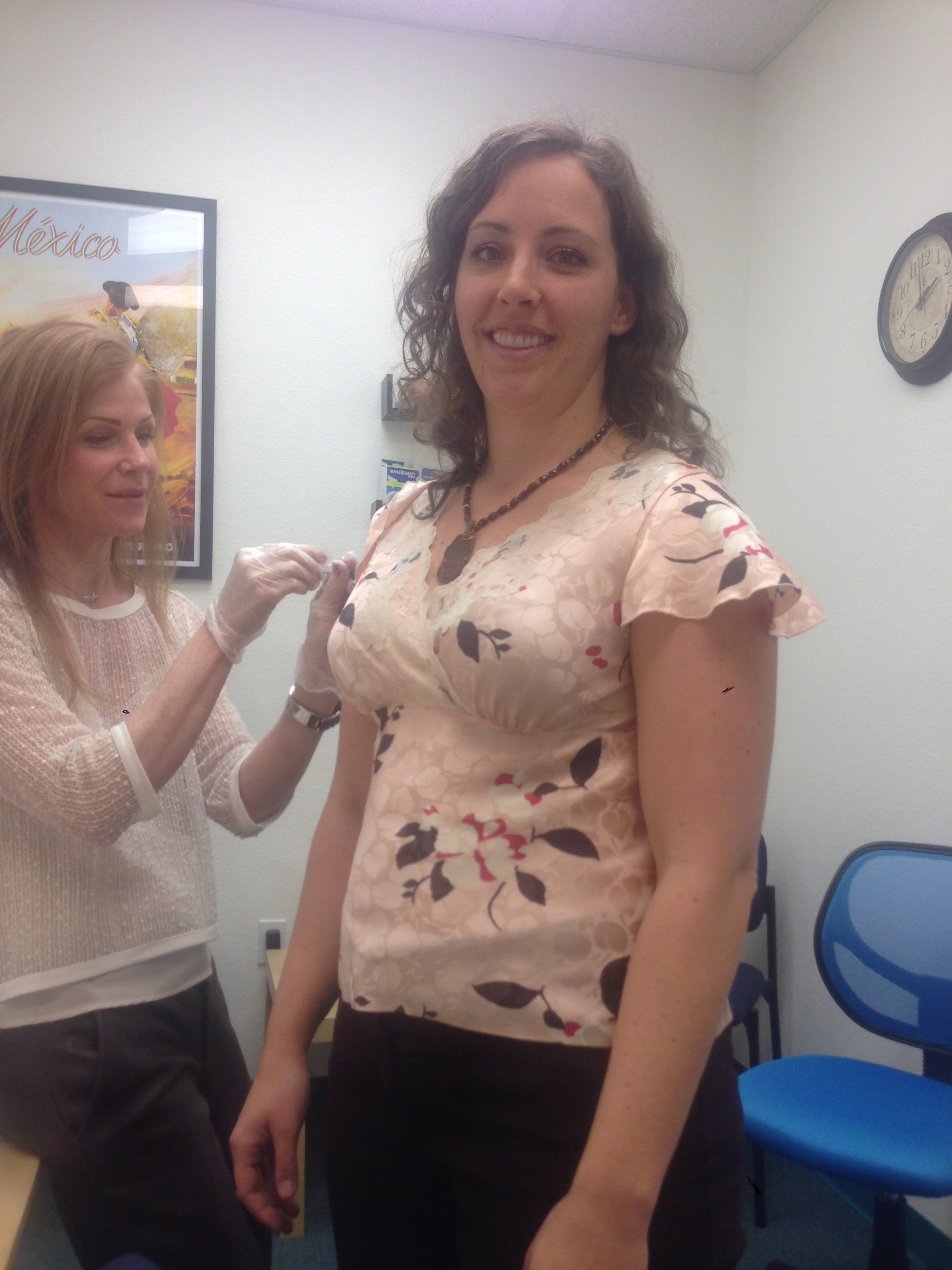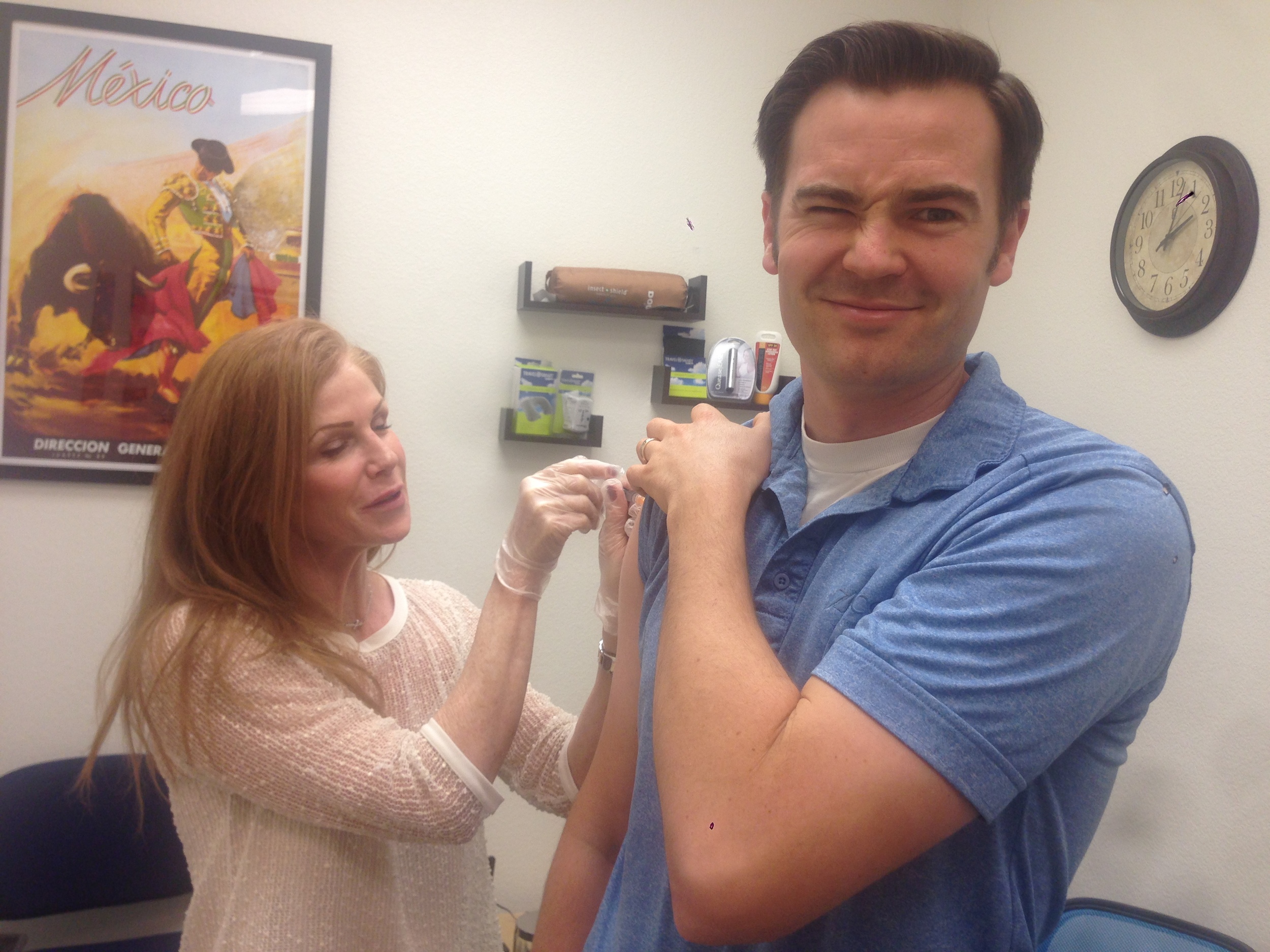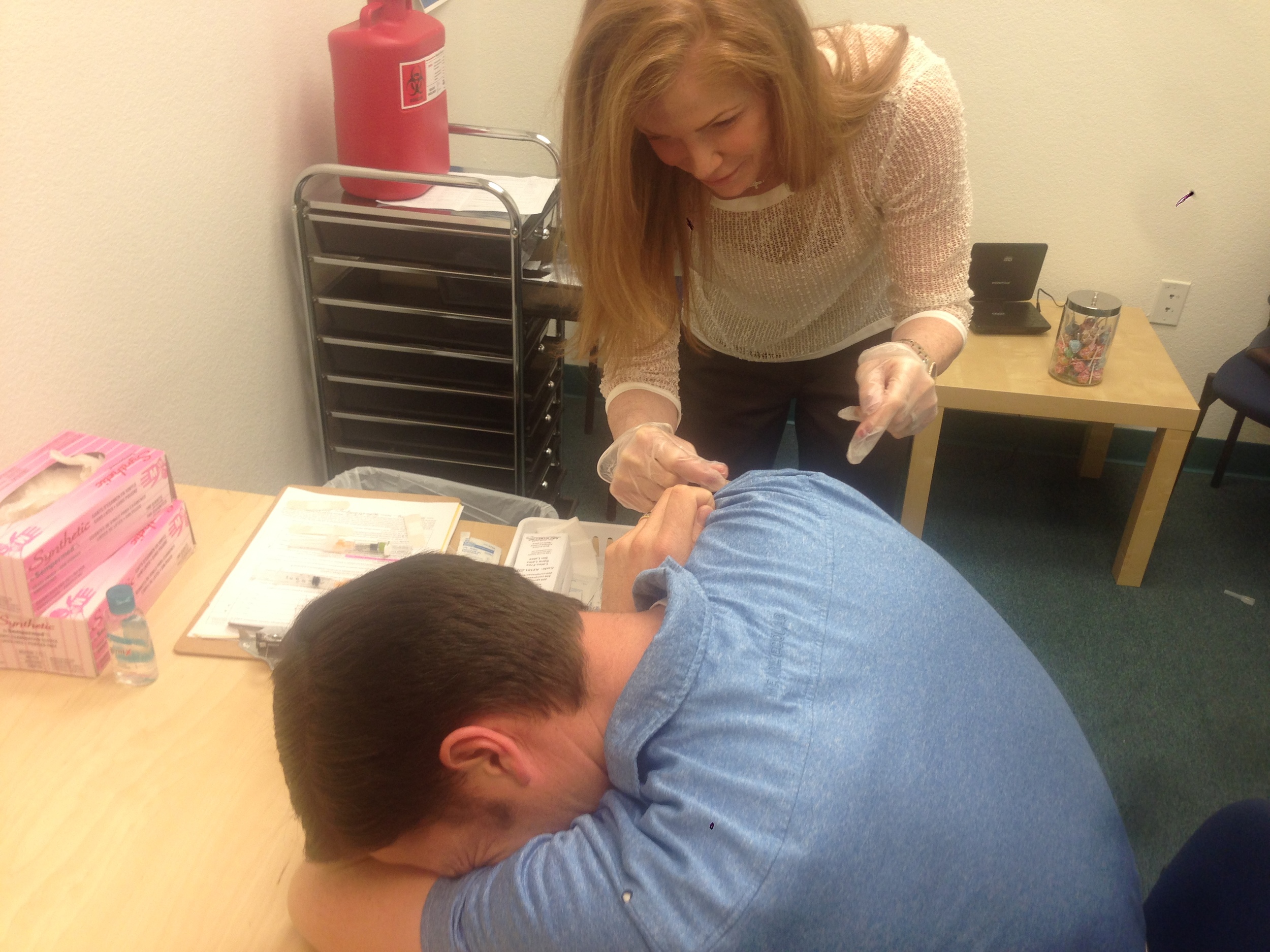Andrew in his “Couch Fall” Protection Gear
Speaking of Typhoid, let's talk about Vaccines. In December of 2014, we briefly thought about setting out a year early, but we had not started the vaccine process. How long could it take, we thought? Alas, quite long. Good thing we looked into it when we did. T-Minus 366 Days Until Cast Off. February 17, 2015, I was walking from Court to my car when my calendar pinged with a new calendar request: "Passport Travel Clinic - Tuesday, February 17", Request from Andrew Godfrey. Before I know it, my Trusty-Right-Hand-Woman has accepted the calendar entry, and there it is. I shake my head.
While my Right Hand Woman is not much for sailboats, she knows all too well the look of a person preparing to do something crazy on a sailboat. When she was young, her mom had itchy feet, too. Her mother decided to sail from California to Hawaii. The Right Hand Woman ended up living in Hawaii with her mom after that, and she tells story of horrendous sea sickness that plagued her anytime she even tried to sail. With all the sailing nonsense we do, all the rigging projects, and now this "Passport Travel Clinic" appointment, she has to be getting suspicious. I revise the appointment to "Doctor's Appointment" and think maybe she'll forget. (Dear Trusty Right Hand Woman: I'm on to you that you are on to me.)
I filled out the vaccination clinic paperwork on the internet. The website asks me to input all of the places I intend to travel, how long I am staying in each place, and what season I will be there.…..I pull out the itinerary and start my input. Soon, I realize that 50+ countries isn't going to fit. So, I just insert a country or two from each region we are heading.
We head over to the Passport Travel Clinic, meet with our Passport Travel nurse, and find she is very excited about our plan. “This will be the biggest CDC information booklet I’ve ever made!” She says, practically clapping her hands together with glee. “Hmm…I’ll have to do some research. You will be traveling in and out of multiple malaria zones. Because the malaria in one zone is resistant to certain drugs and malaria in a different zone is resistant to other drugs, we are going to have to plan several options for you.” She taps and taps on her computer, inserting the names of areas we are heading. She scans the CDC recommendations, then looks up. “Well, this is easy! You’re going to need everything!”
In sum, we decide on the following vaccinations:
Hepatitis A (series of two shots), Hepatitis B (series of three shots), Japanese Encephalitis (series of two shots), Tetnus, Diphtheria and Pertussis Booster, Polio Booster, and Typhoid administered orally. Yellow Fever and Rabies are still under consideration.
After a long meeting, we finally get wheels to the road and start our shots. We had starved Andrew to death, skipping lunch, so the first shot made him feel a little woozy. He held it together and Osmond The Comfort Owl comforted him with a glass of Bailey's Irish Cream in the back yard later that afternoon. I made it through just fine, but that appointment was just the first of many. Vaccines have to be staggered over the course of several months, especially for the Hepatitis and Encephalitis vaccines. They each have multiple boosters, and you have to wait for one to settle in before you can get the next.
In my downtime, I launch into research about the Rabies and the Yellow Fever vaccines. Rabies is extremely expensive ($1500+ per dose), and it is not effective. It might add anywhere between an hour and twelve hours of extra time you have to get yourself to the hospital if you are bitten by an animal with rabies, but you still have to go get a rabies shot if a bite were to occur. While this is somewhat tempting, the cost to effectiveness ration is not balancing out. We decide to forego the rabies shot.
The Yellow Fever Vaccine is a more complicated analysis. Yellow Fever is a mosquito borne illness much like Malaria. It is present in the Canary Islands, parts of Africa and parts of Central America we plan to go to. If you do not have a Yellow Fever Vaccine, you can be denied entry into some countries if you have recently visited a country infected with the virus. It isn’t expensive, and it is rather effective. You usually only need one shot for your entire life, and if you need a booster in older age, your body will handle it much better if you’ve already had the vaccine when you were young. The problem is, the Yellow Fever vaccine has a higher risk of death than any of the others we are considering.
“Andrew, look at this!” I say as I scroll over the CDC paperwork for the Yellow Fever Vaccine. I read aloud, “With the Yellow Fever Vaccine, 1 in 125,000 people experience a ‘severe nervous system reaction’, and 1 in 250,000 people experience life threatening, severe illness with organ failure. More than half of the people who suffer this side effect die.” I look up, waiting for Andrew’s response. He just boinks at me.
“1 in 125,000 people…DIE!” I repeat. Hold the phone, here, people! 1 in 250,000 is not nearly a large enough spread for my comfort. To put this in perspective, the Japanese Encephalitis vaccine simply says "Severe reactions to the JE Vaccine are very rare, estimated at less than 1 in a million doses."
I start digging furiously into additional research on the internet (never wise) only to learn that there have been at least 52 cases of bodies completely checking out within 3-5 days of receiving the vaccine. I learned that they think it may be caused by a thymus disorder or a genetic abnormality in the vaccine subjects. I don't have a thymus disorder, and there is no easy way to test for the genetic abnormality, if that is even the cause in the first place. In sum, there isn't a way to prevent it or even know what factors cause it. So if you want the Yellow Fever Vaccine, you are just going to have to play Russian Roulette with an injection needle.
What about the odds of getting Yellow Fever v. dying due to organ failure from the vaccine? According to the CDC,
The majority of persons infected with yellow fever virus have no illness or only mild illness.
In persons who develop symptoms, the incubation period (time from infection until illness) is typically 3–6 days.
After a brief remission of hours to a day, roughly 15% of cases progress to develop a more severe form of the disease. The severe form is characterized by high fever, jaundice, bleeding, and eventually shock and failure of multiple organs.
Not to worry, people.
You can’t cast off to sail around the world if you haven’t fully rationalized the risk of death and realized in truth it is something we all carry with us, every day. For years, I’ve kept handy the statistics surrounding the likelihood of death during common activities to remind myself what we are doing is actually not as risky as you might think. This is especially true when you consider the risk of dying in a car accident. Andrew drives around 40,000 miles per year for work. His risk of death in a car is rather high, I suspect.
I review my statistics sheet, which, admittedly at this point is getting a little dated.
1
Risk of Dying next year:
Transport Accidents
Pedestrian 1 in 47,273
Pedal Cyclist 1 in 375,412
Motor Cycle Rider 1 in 89,562
Car occupant 1 in 17,625
Even more poignant for the crowd who asks me when I'm having kids:
Lifetime Risk of Death in Childbearing
(includes risk per pregnancy and likely number of pregnancies.)
In North America 1 in 3750
In Europe 1 in 1895
Lain America & Caribbean 1 in 150
In Asia 1 in 105
In Africa 1 in 15SOURCES: http://www.nsc.org/lrs/statinfo/odds.htm - all records from 2002
Conclusion: I have a much higher chance of dying in either a car accident or child birth than I have in dying due to either complications from the yellow fever vaccine or yellow fever itself.
This argument drives my father nuts, though. He works in the smelter of a mine, and has worked in heavy industry all his life. There, the philosophy is that all accidents can be prevented. They require all their workers to memorize the following: TRACK: (T)hink through the task; (R)ecognize the hazard; (A)ssess the risk; (C)ontrol the hazard; (K)eep safety first. To a certain extent, this is right. Accidents are preventable, and you should be doing every thing in your power to engineer safety solutions and prevent problems. In the end, though, sometimes the only preventative measure that can be taken is to just not undertake the task. And when your choice is to not undertake the task, or accept some level of risk, what do you do?
As Andrew tells me all the time: "You can fall off the couch and die" and "Life is inherently fatal." I have been unable to confirm that you can indeed fall off the couch and die, but he's right that someday we will all die. The only way to reach any great reward is to take some risk. While the culmination of my research and philosophical risk of death analysis does not entirely put my mind to rest with regard to the yellow fever vaccine, it allows me at least enough solace that the day of our yellow fever vaccine appointment, I plug my key into the car, turn the ignition, and cross my fingers that I don’t die in an accident on my way to the appointment. I zoom away from the parking garage humming "Que Sera Sera".
It's not that I am being flippant with my life, it's that I'm not in control anyway. If it is my time to die, I will die. Whether it is from a car accident, cancer, the yellow fever vaccine or a brain bleed caused by trying to build a bridge between the "Boomers" and "The Millenniums".







